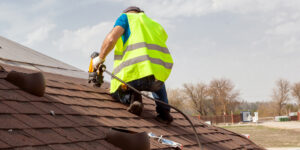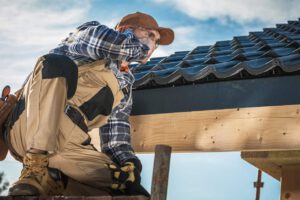A home’s roof can become discolored with streaks, stains, and growths. This may be due to algae or moss. Unchecked moss can cause damage to shingles and void some warranties. Many products can be used to clean a roof. Some are eco-friendly, and others have heavy-duty formulas for tough stains.

Roof Cleaning MT Pleasant does not use any chemicals. Instead, it uses gentle cleansers to remove stains and kill the moss and mold that grow on a roof. It also removes all dirt and grit, leaving the roof sparkling clean and ready for its next rainstorm. The most common roof cleaning method is to spray high-strength chlorine bleach on the moss and algae. This method may have some benefits, such as its low cost and the fact that it can be done from the ground. However, it has several disadvantages. For one, chlorine has a strong chemical odor, and it can kill the surrounding plants. It can also cause oxidation to the asphalt shingles or damage metal roofs. Additionally, the dripping bleach can contaminate gutters and the lawn, killing grass and other plants around the house.
In addition to the strong chemical odor, this method can be extremely hazardous to pets and humans. The chlorine can cause eye and lung irritation. In addition, it can cause a chemical burn to people and pets that come into contact with it. This is because the solution can burn the skin and mucous membranes. The odor can also hang in the air for hours. It can also irritate the nose, throat, and respiratory system of people in the house.
The use of chemicals to clean the roof can also cause damage to the home’s siding and paint. Harsh cleaners can erode the surface of wood or vinyl siding, making asphalt shingles brittle or rust on metal roofs. The harsh cleaners can also drip down the side of the house, causing damage to the siding and killing the lawn and plants.
Many homeowners hire a professional roof cleaning company to remove the stains caused by mold, mildew, and lichens. The best way to protect the environment from these harmful chemicals is to install a downpipe diverter on the roof, preventing the chemical runoff from reaching stormwater systems and the environment. Another way to help the environment is to establish a garden or landscape drain. These will prevent the chemical runoff from damaging the lawn and landscaping.
Although bleach is a popular cleaning solution, it is unsuitable for all roof stain removals. It is a harsh chemical that can damage the roof’s surface and cause long-term deterioration. This can lead to leaks and premature aging of the shingles.
The best way to remove these stains is to use a professional roof cleaner with specific stain-removal chemicals. These cleaners can penetrate deeper and remove the embedded growth of moss, lichen, and algae. They also offer better long-term results than bleach.
Many homeowners must know they can safely clean their roofs with household bleach. However, this is not true, and it can be dangerous for the health of the roof and surrounding property. Bleach in roof cleaning can damage the shingles and tiles, leading to leaks and premature breakdown. It can also contaminate soil and harm plants. Bleach runoff can also pollute water sources, endangering animals and disrupting ecosystems. It is therefore important to debunk this myth and educate homeowners about safer cleaning methods.
Bleach is corrosive and unpleasant, so always wear protective gloves and goggles when working on your roof. You should also avoid working on a windy day, as the chlorine can be carried off by the wind and irritate your eyes and skin. In addition, a bleach solution can erode asphalt shingles and weaken the roof’s structure.
When using a bleach-based solution, you should first wet the foundation plantings down. This will prevent them from the runoff containing sodium hypochlorite. You should then apply the cleaning mixture and let it soak on the roof for 15 to 20 minutes. After that, rinse it thoroughly with a garden hose.
If you are trying to remove a severe buildup of lichen or moss, try using a stronger dilution of bleach. However, you should be careful not to exceed the 50:50 ratio of bleach and water because if the concentration is too high, it may discolor or even dissolve the shingles. This is why it is recommended to use a professional bleach-based roof cleaning product, such as Gloeocapsa magma, rather than mixing your formula.
Despite the claims of many roof cleaning companies, high-pressure cleaning for a roof is not an effective or safe practice. It can cause severe damage to the surface of your roof and even dislodge tiles. It also strips paint from brick and stucco, which can lead to water leaks. Moreover, it can erode the protective layer of the tile, causing it to become porous and susceptible to future damage. High-pressure washing can also be dangerous for humans, as it can damage the skin and eyes. Therefore, it is best to hire a professional to carry out the job.
Before carrying out any high-pressure washing operation on a roof, it is important to prepare the area for spraying. This includes clearing the area of any furniture, portable braais, and cars. It is also a good idea to take note of the wind direction. These factors can affect the spraying process and may cause damage to your property.
In addition, it is essential to ensure all the power outlets are switched off before starting the work. This is because high-pressure water can cause damage to piping and electrical wiring. Additionally, it can cause damage to the gutters and roof underlayment. Sometimes, it can even rip off the shingles and force water leaks.
The ejected water from a pressure washer can also damage the surface of your roof and make it look very uninteresting. In addition, it can cause moss, mildew, and algae to grow. Therefore, it is necessary to remove these substances from the roof before they grow. It is also a good idea to use a biocide to inhibit the growth of these substances on your roof.
In addition to removing these substances, it is important to clean your roof regularly. Most roofs are subjected to constant assault from the elements and must be cleaned periodically. However, using a high-pressure water washer can damage your roof and cause leaks. In addition, it can also rip off shingles and strip the protective powder coating of the roof.
A well-maintained roof is an essential part of your home’s structural integrity and aesthetic. Regular roof cleaning can prevent damage caused by the sun, rain, wind, and debris. However, not all roof cleaning practices are created equal. High-pressure washing may damage the surface of your roof, but low-pressure soft wash cleaning is safe for all types of roofing materials.
When a pressure washer is used to scrub a roof, it uses water that can reach up to 2800 PSI (pounds per square inch). This can break tile or shingle tiles, cause cracks in the chimney stack bricks, and erode the concrete surfaces of walls and driveways. Low-pressure soft washing, on the other hand, uses a gentle nozzle that can remove dirt and stains without damaging your property.
Low-pressure soft wash involves using a specialized roof cleaner that contains surfactants and other cleaning mechanisms. These chemicals work together to remove fungus, mold, mildew, and other contaminants. This process is environmentally friendly and doesn’t use abrasive detergents or bleach.
It is important to choose a roof cleaning company that complies with your local environmental regulations. It is illegal for contractors to dump dirty water down gutters and into streams, dams, rivers, and creeks, endangering wildlife and contaminating the surrounding environment. It is also recommended that companies have a system to recycle all grey water from the roof washing process and use it back on gardens, lawns, and around plants.
In addition to reducing the risk of pollution, low-pressure cleaning will extend the life of your roof by removing black streaks. This is important, as the spores that breed damaging fungus on your roof will eventually clog shingles and gutters. If left unattended, this can lead to roof leaks and the need for a costly replacement.
Another benefit of low-pressure soft washing is that it does not damage granules, which can lead to expensive repair bills in the future. The low-pressure rinsing is also safer for people with allergies and sensitivity to harsh chemicals. In addition, it is environmentally friendly and does not leave behind any traces of chlorine or sodium hypochlorite on the surface of the property.


